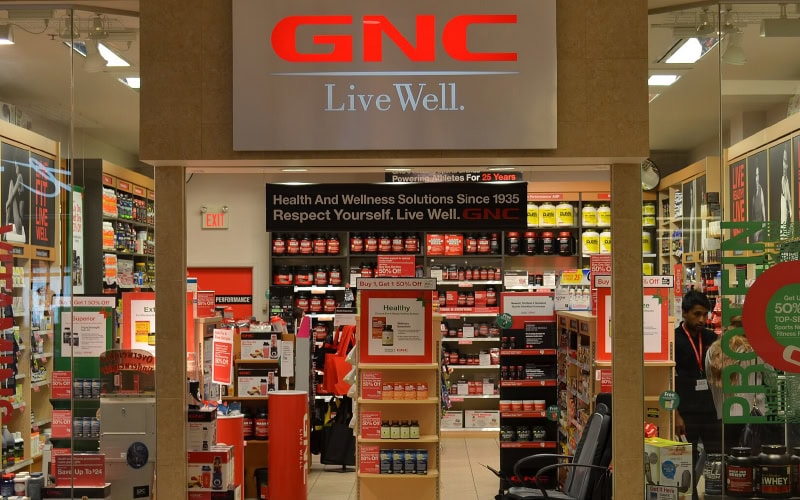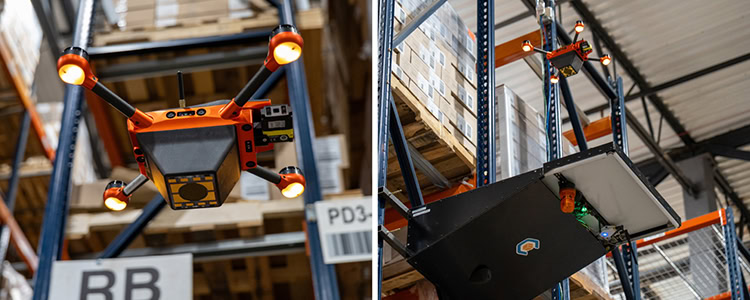GNC’s Inventory Takes Flight

GNC, a leading health and wellness brand, was looking to streamline its system for conducting physical inventories. Because the system was largely manual, and given the number of employees and the amount of equipment required for each inventory session, GNC would complete only several full cycle counts each year.
THE CUSTOMER
GNC is a multinational retail and nutritional manufacturing company based in Pittsburgh, Pennsylvania. It specializes in health and nutrition related products, including vitamins, supplements, minerals, herbs, sports nutrition, and diet and energy products.
THE PROVIDER
Corvus Robotics sells AI-driven robotics, software, and data-driven insights to companies and governments as a better way of providing inventory visibility across the material flow.
To streamline the process and enable more frequent and accurate inventories, GNC implemented an Autonomous Inventory Management System from Corvus Robotics. This solution uses drones to automate cycle counts, freeing labor and equipment and boosting efficiency and accuracy.
From its start as a single store in 1935, GNC has expanded across the globe. It operates a mix of company-owned retail locations, domestic and international franchise locations, digital commerce, and wholesale and retail partnerships, with a product lineup that ranges from apple cider vinegar to jojoba oil to turmeric caplets.
Two distribution centers, one in Arizona and one in Indiana, support GNC’s retail, wholesale, international and ecommerce businesses. Between them, the two facilities house 40,000 bin locations that need to be regularly inventoried.
Prior to GNC’s partnership with Corvus Robotics, taking a physical inventory required teams of employees who manually counted all products. To physically reach each item, employees sometimes used material handling equipment. The challenge? This equipment also was needed for customer operations, and shifting it to the audit team could impact how quickly customer orders were filled.
“There was always a conflict between who was able to get the equipment and who wasn’t,” says Bill Monk, vice president of distribution. Given both the human and material handling equipment resources required, full cycle counts were completed between two and four times annually.
Complex Inventory Management

Corvus autonomous drones manage inventory at GNC’s distribution centers, improving accuracy and reducing shrinkage. By automating daily cycle counts, the drones free up labor and equipment, enabling faster, more efficient order fulfillment.
Inventory management for perishable products is generally more complicated than it is for nonperishable ones, says Jackie Wu, founding chief executive officer with Corvus Robotics. There are stricter rules and regulations for traceability purposes, and these rules also differ based on the country.
The regulations are intended to ensure product quality, safety, and public health. Moreover, many companies that offer perishable and edible products face more frequent inspections to ensure compliance with food safety standards.
On top of this, the number of inventory movements that occur within any warehouse can lead to misplaced products and inventory errors. However, the employees who fill customer orders need to know the exact location of every product to ensure timely, accurate fulfillment.
At GNC, employees who fill orders need to account for both expiration dates and lot numbers for each customer. For example, a wholesaler in one country might have a nine-month expiry date requirement, and another wholesaler in a different country, a 12-month expiry date.
To address these challenges, Monk and his team began researching solutions that would enable them to more accurately and efficiently track and count products within the distribution centers. GNC first observed the Corvus drones at an industry conference.
Corvus Robotics’ inventory management system deploys autonomous drones that, in contrast to some other solutions, don’t require beacons, reflectors, or other devices to navigate.
Instead, the system uses embodied artificial intelligence (AI) composed of a mix of neural networks, machine learning and computer vision that together enable the drones to learn the layout of a warehouse and the locations of the products within it. This allows the drones to boost the efficiency and accuracy of the inventory process without requiring changes to the warehouse layout or racks.
The inventory process is Corvus’s sole focus. “We don’t do picking, moving, transport, or unloading,” Wu notes.
Corvus’s data-driven “robots as a service” model allows companies to quickly respond to changes in demand, reduce labor costs, and/or enhance the customer experience as they need to. For instance, if a company decides to increase the frequency of its inventory audits, it might accomplish this by increasing the number of flights its existing drones complete, or by adding more drones.
ROI in Six Months
The cost to deploy the Corvus solutions is typically an “order of magnitude cheaper than other options for conducting inventory,” Wu says. Most customers begin generating a return on their investments within six months, he adds.
A significant differentiator between the Corvus solution and some competitors, Monk says, is its ability to provide a detailed accounting of the products it inventories. Many other inventory options can indicate, for example, that a pallet is in a certain location, and then will scan the barcode and location to check for a match. However, GNC needs to know not just where a pallet is within its distribution center, but the type and number of cases on it.
The drones can provide this by taking a picture or video that shows the location of the cases of the products. This allows the GNC inventory team to compare the detailed images to the company’s records, checking that the two match.
Before implementing the system, GNC provided Corvus with CAD drawings and layouts of its two distribution centers. The Corvus team also conducted a site survey to ensure the drones could travel through the different areas of the facilities.
For example, one of GNC’s distribution centers contains multiple overhead conveyors. For the system to succeed, the drones need to be able to navigate below the conveyors.
Corvus also tested the drones and landing pads—these charge the drones and facilitate the transfer of data from the drone to GNC’s information systems—to check whether any adjustments to the power or lighting were needed. They determined that GNC could have multiple landing pads along with one drone that would “leapfrog,” from pad to pad to cover the building.
“Within weeks we were up and running,” Monk says.
“A Beautiful AI Model”
During most implementations, Corvus typically conducts test flights to gather data about the facility, including the layout, the inventory, and the format of the barcode labels. The drones automatically collect this data to train the AI model on that specific customer and warehouse. The drone then updates its information every time it flies.
“We get a beautiful AI model” of the warehouse, as well as the inventory, barcodes and labels, Wu says.
For example, once a drone is trained, it knows that, based on the information from the warehouse management system, all sizes of blue T-shirts should be in Aisle 1, Bins A, B, C, and that the red T-shirts should be in Aisle 2, Bins A, B, C. The drones don’t see the individual shirts in the boxes, but they will capture the cases that contain them.
The drones scan every pallet moving through the GNC distribution network to double check and verify inventory accuracy. Like GNC, most companies are up and running within several weeks, Wu says.
The Drones in Operation
The drones can read either barcode or OCR labels, and they can mostly operate 24/7, Wu says. While each customer determines the flying schedule for its drones, Corvus suggests using them during slower or off hours for additional safety.
In keeping with standard warehouse hygiene practices, it also helps to have aisles clear of obstacles, Wu says. The number of landing pads to drones needed depends on the facility’s size and layout, among other factors.
At GNC, the drone starts its first flight around 10 a.m., and then heads out again every couple of hours, ending at about 3:00 the next morning. Associates have grown accustomed to “white noise in the background” that the drones generate, Monk says. “It’s just part of our everyday life in the building,” he adds.
Once a drone completes its flight and returns to the landing pad, it downloads the data and provides reporting, which an employee reviews and checks for any discrepancies.
The drones have helped GNC in multiple ways. They’ve enabled the company to reduce its inventory control team from 20 to 13, allowing some individuals to shift roles that are more meaningful to them. Similarly, the drones can operate without requiring material handling equipment, freeing it for other uses.
Errors and shrinkage have been significantly reduced, leading to improved stock reliability.
Because the drones can provide real-time inventory data, they improve GNC’s ability to quickly locate misplaced inventory and reconcile discrepancies, which helps prevent disruptions to order fulfillment operations.
GNC is now able to fully inventory products at least 10 or 12 times a year, so it can identify any errors more quickly. “I like to say that bad news doesn’t get better with time,” Monk says.
Generally, the earlier a problem is caught, the easier it is to fix, and the more likely employees can take steps to keep it from happening again.
Casebook Study: Soaring With Drones
The Challenge
GNC’s largely manual inventory system consumed both human and equipment resources, so inventory was conducted only a few times each year. This meant errors might go undiscovered for some time.
The Solution
GNC implemented an Autonomous Inventory Management System from Corvus Robotics. The Corvus drones use embodied artificial intelligence (AI) to learn the layout of a warehouse and the locations of the products within it. With this information, they’re able to automate cycle counts, freeing labor and equipment and boosting inventory efficiency and accuracy.
The Results
Among other benefits, the drones have increased inventory accuracy and visibility, and enabled faster error resolution, which helps to prevent disruptions to order fulfillment operations. They’ve also enabled a reduction in the staff required to conduct inventories.
